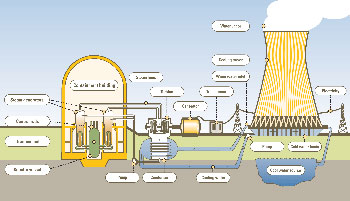Following the Japanese Fukushima-Daiichi power plant disaster that was triggered by the Earthquake and the subsequent Tsunami that followed, it is imperative for most of us to understand how the Nuclear Power and the Plants therein work.


Following the Japanese Fukushima-Daiichi power plant disaster that was triggered by the Earthquake and the subsequent Tsunami that followed, it is imperative for most of us to understand how the Nuclear Power and the Plants therein work.
The nuclear power plants are a symbol between our greatest hope for sustainable energy requirements on one hand and the worst nightmare of our very existence! Going by number of past experience, we can say that, Nuclear energy might be a necessary evil, is it? Much as we may hate it, atomic energy offers a clean energy alternative that frees us from the bonds of fossil fuel dependence.
On the other hand, it brings memories of disaster like the quake ruptured Japanese power plants releasing radioactive steam, or the dead zone surrounding USSR Chernobyl’s concrete barrier.
That said and done, what happens inside a nuclear power plant to bring such wunderkind and melancholy into being? Imagine following a volt of electricity back through the wall socket, all the way through kilometres of power grids to the nuclear reactor that generated it.
You would meet the generator that produces the spark and the turbine that turns it.
Next, you’d find the jet of steam that turns the turbine and finally the radioactive uranium bundle that heats water into steam.
The water in the reactor also serves a duo purpose, as a coolant for the radioactive material, preventing it from overheating and melting down as well as producing the super-heated steam that turns the turbines!
In March 2011, TV viewers around the world became well acquainted with this reality as Japanese citizens fled in their thousands from the area surrounding the Fukushima-Daiichi nuclear facility after the most powerful earthquake on record and the ensuing tsunami inflicted serious damage on the plant and several of its reactor units.
Among other events, water drained from the reactor core, which in turn made it impossible to control core temperatures.
This resulted in overheating and a partial nuclear meltdown. According to the WNA (World Nuclear Association) as of March 1, 2011, there were 443 operating nuclear power reactors spread across the planet in 47 countries.
In 2009 alone, atomic energy accounted for 14 percent of the world’s electrical production. Break that down to the individual country and the percentage skyrockets as high as 76.2 percent for Lithuania and 75.2 for France.
In the United States, 104 nuclear power plants supply 20 percent of the electricity overall, with some states benefiting more than others.
Nuclear Fission – That said and done, all the interplanetary energy that the word "nuclear” invokes, power plants that depend on atomic energy don’t operate that differently from a typical coal-burning power plant.
Both heat water into pressurized steam, which drives a turbine generator. The key difference between the two plants is the method of heating the water.
While older plants burn fossil fuels, nuclear plants depend on the heat that occurs during nuclear fission, when one atom splits into two and releases energy. Nuclear fission happens naturally every day.
Uranium, for example, constantly undergoes spontaneous fission at a very slow rate. This is why the element emits radiation, and why it’s a natural choice for the induced fission that nuclear power plants require.
Uranium is a common element on Earth and has existed since the planet formed. While there are several varieties of uranium, uranium-235 (U-235) is the one most important to the production of both nuclear power and nuclear bombs.
(To be cont’d)
eddie@afrowebs.com


